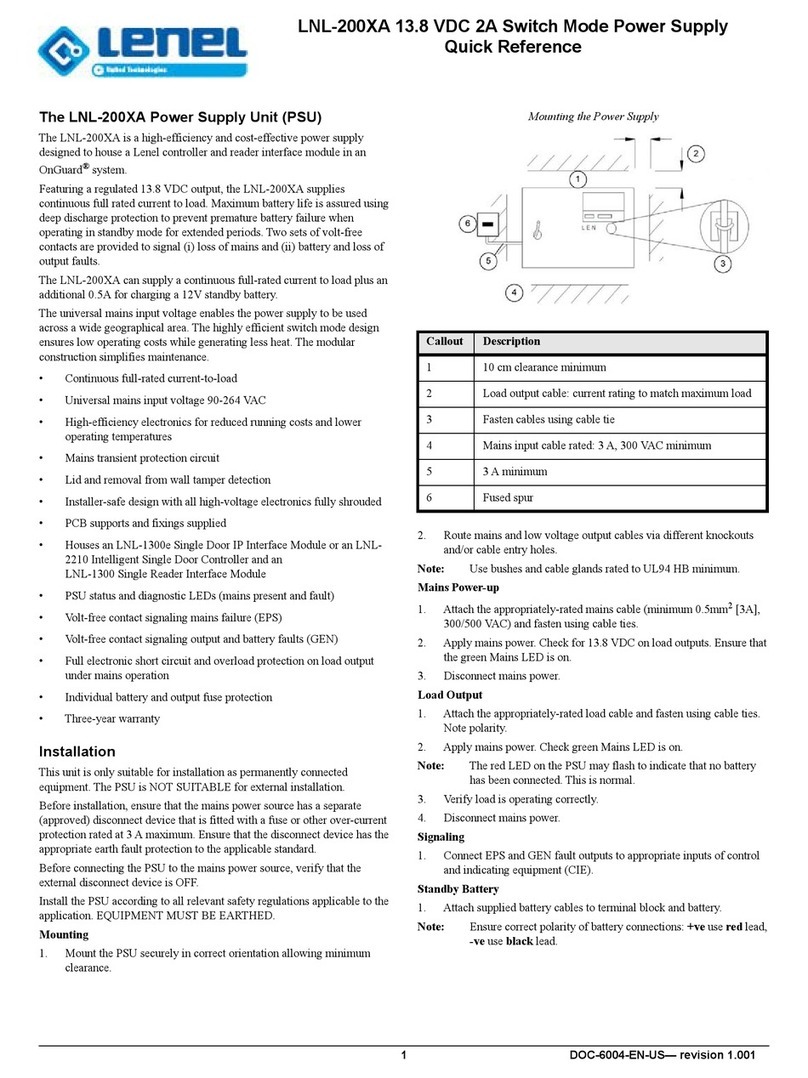
© 2020 Carrier. All Rights Reserved. LenelS2 is a part of Carrier. 1 DOC-6013-EN-US — revision 1.002
The LNL-300XA 13.8 VDC 4 A Battery Monitoring
Switched Mode PSU
The LNL-300XAis a high-efficiency and cost-effective power supply
designed for use within a Lenel access control system.
Featuring a regulated 13.8 VDC output, the LNL-300XAsupplies
continuous full rated current to load, and a universal mains voltage input.
Maximum battery life is assured using deep discharge protection to prevent
premature battery failure when operating in standby mode for extended
periods. Two sets of volt-free contacts are provided to signal (i) loss of
mains and (ii) battery and loss of output faults.
Other features of the LNL-300XAinclude:
• Continuous full-rated current-to-load
• Universal mains input voltage 90 to 264 VAC
• High-efficiency electronics for reduced running costs and lower
operating temperatures
• Mains transient protection circuit
• Lid and removal from wall tamper detection
• Green mains present LED
• Red fault diagnostic LED
• Volt-free contact signaling mains failure (EPS)
• Volt-free contact signaling output and batter faults (GEN)
• Full electronic short circuit and overload protection on load output
under mains operation
• Individual battery and output fuse protection
Installation Instructions
This unit is only suitable for installation as permanently connected
equipment. The PSU is NOT SUITABLE for external installation.
This unit must be fed from a mains power source that has a separate
(approved) disconnect device and is fitted with a fuse or other over-current
protection device rated at 3 A maximum. Ensure that the disconnect device
used has appropriate earth fault protection to the applicable standard.
Before connecting the PSU to the mains power source, verify that the
external disconnect device is OFF.
Install the PSU according to all relevant safety regulations applicable to the
application. EQUIPMENT MUST BE EARTHED.
Mounting
1. Mount the PSU securely in correct orientation allowing minimum
clearance.
Mounting the Power Supply
2. Route mains and low voltage output cables via different knockouts
and/or cable entry holes.
Note: Use bushes and cable glands rated to UL94 HB minimum.
Mains Power-up
1. Attach the appropriately-rated mains cable (minimum 0.5mm2[3A],
300/500 VAC) and fasten using cable ties.
2. Apply mains power. Check for 13.8 VDC on load outputs. Ensure that
the green Mains LED is on.
3. Disconnect mains power.
Load Output
1. Attach the appropriately-rated load cable and fasten using cable ties.
Note polarity.
2. Apply mains power. Check green Mains LED is on.
Note: The red LED on the PSU may flash to indicate that no battery
has been connected. This is normal.
3. Verify load is operating correctly.
4. Disconnect mains power.
Signaling
1. Connect EPS and GEN fault outputs to appropriate inputs of control
and indicating equipment (CIE).
Standby Battery
1. Attach supplied battery cables to terminal block and batteries.
Note: Ensure correct polarity of battery connections: +BAT use red
lead, -BAT use black lead.
LNL-300XA 13.8 VDC 4 A Battery Monitoring
Switched Mode PSU Quick Reference

























